Sharlyn J. Lauby's Blog, page 86
February 4, 2020
Employee Engagement: 3 Things We All Want from Work
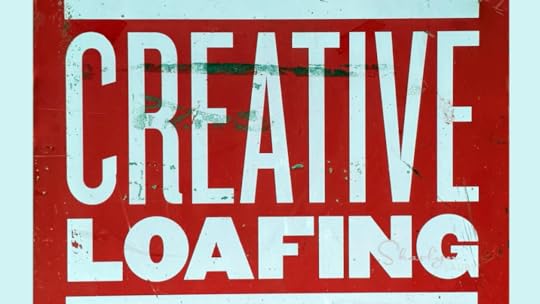
Organizations are constantly asking themselves “What do our employees want?” And if they’re not asking that question, they should be. The answer helps organizations create a workplace that employees want to be a part of. That aids employee engagement. It helps companies create jobs and programs that employees enjoy. It also allows employees to do their best work (and, no, not more creative loafing).
Last year, I worked on a series of articles with our friends at Kronos about this very topic. What do employees want? While you read these articles over the course of time, I really think having them in the same place paints a picture about the future of work and the things that employees are expecting from their employer. So, I wanted to put the series together in the same place as a reference.
Organizational
Trust is the Key to Innovation
Trust is the basis of good employee engagement. Kronos shows
us, through Project Falcon, that trust and engagement can also hold the key to
innovation.
Working
Smarter Means Organizations Need to Personalize Work
Working smarter means different things to companies. But we
know we need to do it. The key may be personalizing work.
Employees
Want to Work with Technology in the Modern Cloud
The right technology can help employers provide a modern
cloud-based workplace. This is the employee experience that builds engagement.
The
Future of Work: Employees Want to Work Their Own Way
The future of work has many drivers. Employees want to work
smarter and in the modern cloud, which shows us that employees really can own
their careers.
Organizations that want to compete for talent need to deliver the answer to the question “What do employees want?” It’s an important part of employee engagement. I understand that there might be subtle nuances based on geography, industry, and company size.
But there are some things that all employees want. They want to work for companies where they are trusted. Employees want their work personalized and they want to have access to the technology tools to do good work. Finally, they want to know they have a future with the company. That’s the answer to the question.
Image captured by Sharlyn Lauby while exploring the streets of Tampa, FL
The post Employee Engagement: 3 Things We All Want from Work appeared first on hr bartender.






February 2, 2020
The Pros and Cons of Working From Home – Ask #HR Bartender

I published an article a couple of months ago about “The Future of Work: Employees Want to Work Their Own Way”. Afterward, I received a nice note asking about telework.
You are so right Sharlyn. In 2019,
being able to own your career and be proud of what you do is something most
employees dream of. But I’d like to hear your thoughts on giving office workers
to work from home (i.e. the ‘freedom to work from home’ or ‘the ability to work
from home’).
On one hand, it’ll likely give
employees more time to get more work done (due to a lack of commute, the
ability to work without getting properly dressed every morning, etc.), but on
the other, the freedom, lack of supervision, and all the enticing functions of
a home (bed, TV, pets, etc.) might undercut the extra time they gained by
giving them numerous reasons to procrastinate.
This
reader is absolutely right. The benefits of working from home include not
having to deal with traffic and a long commute. It can also be helpful not to
have to think about getting dressed for a professional office environment.
(Please note: This should not be interpreted as condoning bad hygiene.)
And there is a potential downside. Working from home can be distracting depending on your situation. I know people who say that pets and other family members can cut into their productivity. Even when you don’t have those things, sometimes we’re our own worst enemy and things like Facebook, sunny weather, or the latest episode of Lucifer can be a distraction.
There
are things organizations and individuals can do to leverage the advantages and
minimize the disadvantages of telework. Here are some resources that might
help:
6 Different Types of Flexible Work
Employee
retention is a top priority today. Employee caregivers face many obstacles.
Companies can help by offering flexible work options.
How to Design Your Company’s Flexible Workspace Plan
Flexible
work brings opportunities to both the business and employee. There are many
ways to design flexible workspace. Here’s one example using Home, Roam, Hub and
Club.
6 Tips for Successfully Working at Home
For
many, working at home is the dream. But there can be a lot of challenges too.
Here are a few tips to help you successfully work from home.
Managing Work and Home Demands
Managing
home and work demands can be a real balancing act. Employees want to be successful
at telework, but managers need training for it.
Regardless
of whether you’re an employee or an organization, if you’re thinking that you
might like to explore telework, it may make sense to create a test-run or
experiment. Define the parameters. Both the employee and employer need to agree
on why you’re giving telework a try, what’s expected in terms of manager and
employee performance during the trial run, and what will happen after the test
period expires. Open communication throughout the experiment is essential.
There
are so many outcomes that could occur as a result of the experiment. The
employee could hate working from home. They could love it and be incredibly
productive. The manager could find it really difficult to manage remote employees.
Or they could find that their relationship with the employee gets stronger.
Working from home has definite pros and cons. Employees and organizations can create a win if they want to.
Image of Ernest Hemingway’s home office captured by Sharlyn Lauby just outside of Havana, Cuba
The post The Pros and Cons of Working From Home – Ask #HR Bartender appeared first on hr bartender.






January 30, 2020
Employees Don’t Want to Regift Their Benefits
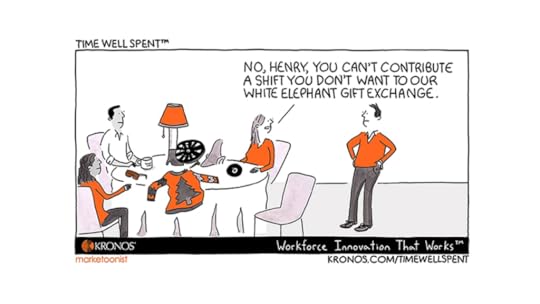
(Editor’s Note: Today’s article is brought to you by our friends at Kronos , a leading provider of workforce management and human capital management cloud solutions. The Workforce Institute at Kronos has a new book out, Being Present: A Practical Guide for Transforming the Employee Experience of Your Frontline Workforce . Enjoy the article!)
Over the holidays, I saw several articles debating
regifting. Is it okay? Or is it rude? One thing I believe that everyone agrees
on is the point that, if you do decide to regift, you should find a way to do
it where you don’t hurt anyone’s feelings.
I was reminded about regifting when I saw today’s Time Well Spent from our friends at Kronos. It’s important to
give employees things that they want and appreciate in a way that they will
respond to positively. I’m not just talking about work shifts, but benefits,
perks, training, and workplace culture. You get the point.
When it comes to gifts, you won’t make everyone happy. But you should try. Years ago, I worked for a company that wanted to give employees recognition gifts from a very expensive well-known company. The CEO said that he wanted employees know how much he appreciated them so only “the best” would do. Employees saw it differently. Most of them made minimum wage and had no use for the pricey gifts. They took them to a local pawn shop to get the financial benefits. While I could see both sides, it still hurt feelings on both sides – employees thought the CEO was out of touch and the CEO felt employees didn’t appreciate the gift.
If you don’t know what employees want or like, ask them. When I was the volunteer president of a non-profit, I got other board members involved in volunteer gifts. The items that they proposed weren’t things that I would have ever thought of and I must admit I wouldn’t have thought that anyone would have liked them. But the volunteers loved them! The activity taught me how valuable it was to get others involved because those different perspectives can make a difference, especially when it comes to gifts and recognition.
Give employees an opportunity to do some regifting without guilt. Organizations don’t have to organize gift exchanges like in today’s cartoon. Although some people might find it fun. But when it comes to things like work shifts, employees would appreciate the benefits of a quick and easy way to make a shift swap. And today’s technology solutions allow that to happen along with giving supervisors an easy way to approve it. Which is great because employees can regift when their schedule doesn’t suit them. No hurt feelings.
The last thing organizations should want to do is give an employee something they immediately want to regift. That being said, organizations also aren’t in a position to give employees personalized gifts. So, create a perfect balance with benefits. Give employees the things they want AND give them an easy way to exchange them if necessary.
The post Employees Don’t Want to Regift Their Benefits appeared first on hr bartender.






January 28, 2020
7 Recruiting Activities That Can Improve the Candidate Experience

Whether you’re new to recruiting or bring years of
experience to the table, you know that the candidate experience is important.
Candidate impressions not only influence whether the candidate decides to take
the job, it can also impact the company’s brand, which in turn can help or hurt
the company’s bottom-line.
In my experience, organizations are always looking for tips
and resources to improve their candidate experience. Sometimes it’s new ideas
they haven’t tried. In other cases, it’s old ideas that they forgot worked.
Here are seven articles that might spark some creative inspiration.
1. Connect and Engage with Job Candidates Using These 5 Recruiting Strategies
Recruiting
strategies can help your business succeed so choosing the right strategy is
important. Here are 5 recruiting strategies to consider.
2. Is It Okay to Contact a Job Candidate Via Their Work Email?
A job
candidate may give recruiters their work email. Is it okay to contact them
there? Several recruiters tell us how to handle candidate work emails.
3. Hiring Managers: 3 Strategies to Recruit and Select the Best Talent for Your Team
The
hiring process can be overwhelming for many managers. Read this list of 3
strategies to find the right talent and make hiring easier.
4. Recruiting Biases: 10 Common Types
Biases
can prevent hiring managers from focusing on the true candidate. Awareness of
biases can help. Here are the 10 most common recruiting biases.
5. Social Media Background Checks: Are They Okay?
Social
media background checks have become a regular part of recruiting. Attorney
Heather Bussing shares her thoughts on using social media this way.
6. Candidate Experience: Engaging Job Seekers During the Silent Period
Candidate
experience can be improved by engaging job candidates during the silent period
– those periods when they don’t hear from you. Here are some solutions.
7. Onboarding: Take Your Process from Basic to Strategic
Onboarding
is the foundation of employee engagement. Be strategic in your onboarding
process following these 4 trends that engage new hires.
Recruiting teams need to be prepared for a challenging 2020. It’s still a candidate’s market. The good news is that organizations can continue to improve the candidate experience in ways that cost very little. Those activities can make a big difference in attracting the right talent.
Image captured by Sharlyn Lauby while exploring The Margaritaville Resort in Orlando, FL
The post 7 Recruiting Activities That Can Improve the Candidate Experience appeared first on hr bartender.






January 26, 2020
How to Figure Out the Next Step In Your Career

During the Great Recession, I was
asked (along with a few other people) to come to the local unemployment office
and provide some advice to individuals who had their jobs eliminated and were
considering entrepreneurship as their next career. The conversations were
exactly what you would expect. We were answering questions about how we became
consultants, our biggest challenges, etc.
In fact, it was very similar to the process I followed
before becoming
a consultant. I had taken the time to speak with people who were
consultants about how they got their start.
The reason I’m sharing this story is because a lot of the
people who were trying to figure out if consulting was right career move for
them were really struggling with the decision. What they really wanted was
someone to answer the question: “Do I focus on trying to get a job inside a
company or do I focus on starting my own company?” It’s a big decision and one everyone
needs to make on their own.
I’ve always said that one of the ways you can determine the
right career move is by answering these two questions:
Think about a time when you were your most productive. What did that look like in terms of the work you were doing, the team you were a part of, how you were recognized and rewarded, your boss, etc.?Now do the reverse. Think about a time when you were your least productive. Remember what that time looked like in terms of your work, the team, your boss, the work environment, etc.
The answers to these two questions are often very
enlightening and can point you in the right direction where your career is
concerned because they answer what you like and don’t like in a job.
I recently discovered another activity that you could do to
help you get focus on your next career step. The goal of this activity is to
determine what drives and excites you from a work perspective. Bridge, an
employee development platform, sent me a deck of Bridge Career Driver cards. You can get a set for
free by completing a form on their website. The cards have six colors
representing six driver categories. Step one is to select three drivers from
each category.
Next, those selected cards are shuffled, and five cards are
placed face up. Think of this as the initial top five drivers. Individuals
choose a card from the shuffled deck and decide – Do I want to move this into
my top five? And if so, what will it replace? This forces us to prioritize our
top drivers and/or motivators.
Finally, once the top five drivers have been established, place
a pen (or long object) above and below the cards. Move the cards up toward the
top pen if your current needs in that driver area are being met. Move the cards
down toward the bottom pen if they aren’t. (P.S. Don’t worry about remembering
all these steps. The
activity is on their website.)
Bridge recommends that this activity be conducted between a
manager and employee to gain insights about what drives employees. I totally understand.
But I can also see doing this privately as a career development activity. I
could see doing the activity each year as part of setting professional goals. And
best of all, the cards are FREE!
Figuring out our next career move is hard. There are many things to consider. Don’t let the simplicity of a card activity fool you that this activity was easy. The card activity provides a structured way to effectively guide career decision making. If you’re trying to plan your next career move, it might be worth checking out.
Image captured by Sharlyn Lauby after speaking at the SHRM Annual Conference in Las Vegas, NV
The post How to Figure Out the Next Step In Your Career appeared first on hr bartender.






January 24, 2020
Bookmark This! Labor Law Posters Edition #MindTheGap

As a human resources professional, compliance is a necessary part of our role. Making sure the organization is compliant allows us to shift our attention to other aspects of our job like talent acquisition plans, employee engagement strategies, and retention efforts.
In addition, employees don’t want to work for organizations that aren’t compliant. It’s a red flag. If a company doesn’t follow the law in this area, then where else aren’t they following the law. Take labor law posters for example. Last year, we ran a series of articles about labor law poster compliance with our friends from Poster Guard. You might find it helpful to see all of the articles together, so here’s the entire series in one place.
3
Employee Groups with Unique Posting Requirements
Labor law posters are required by law. And they differ for unique groups. Here are 3 employee groups with unique requirements. Mind the gap!
Workplace
Posting Requirements for Remote Workers
Remote workers are the new normal. Like any employee, remote
workers have legal requirements. Attorney Ashley Kaplan from Poster Guard
shares her expertise.
Different
Industries Require Different Posters
Labor law posters are a legal requirement. But not every industry requires the same postings. Businesses must mind the gap in compliance with their posters.
4
Key Elements of a Successful Labor Law Posting Strategy
Compliance is important but we need to be efficient. Create a labor law poster strategy to keep you in compliance and find partners to help.
Being compliant sends the message to employees that
following the law is important to the company. Not only is the organization
doing the right thing, but it expects employees to do the same.
It doesn’t make any sense to fight the compliance part of
human resources. But that doesn’t mean we have to give it the majority of our
time. Finding effective and efficient ways to manage compliance allows HR to
focus on being a valued business partner.
The post Bookmark This! Labor Law Posters Edition #MindTheGap appeared first on hr bartender.






January 23, 2020
Employee Benefits: Trends to Watch
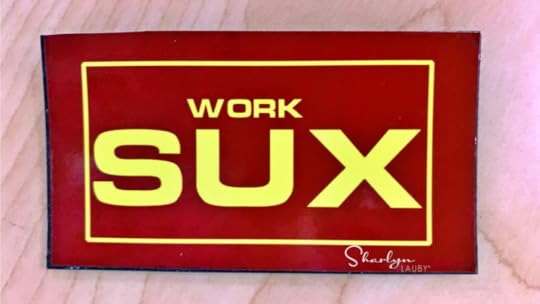
As business professionals, I’d like to think that we all
realize compensation and benefits are important. I agree that employees want to
work for companies with a positive brand. They want to do meaningful work. Employees
want supportive managers and coworkers. But there’s a basic assumption that the
employee is being paid internally equitable and externally competitive.
Compensation is important because it plays a role in
performance and employee recognition. Organizations use performance to
determine who gets a promotion. They use performance to tell employees they’re
doing a good job (and conversely coach them when they’re not).
5
Factors That Connect Performance and Compensation
Performance is how employees help
the organization thrive and grow. It’s smart to separate performance from pay.
But organizations have to be consistent.
Give
Employees Recognition and Rewards That Matter
Recognition and rewards help build
employee engagement. But only if they rewards are valued by employees. Kronos
shows how recognition really matters.
I’d also like to think that we would agree that benefits and
perks should be considered a part of total compensation. Last year, you weighed
in on several topics that had to do with employee perks, benefits, and the
workplace. I think we’re going to see more of these topics this year.
Employees
Love to Listen to Music While They Work
Music at work may be a requirement
for most employees. Poll results show 98% want to listen to music at work. Here
are the top music genres employees want.
Travel
Incentives: 4 Great Reasons to Offer Them to Employees
Travel incentives offer unique
employee experiences. They are also a meaningful expression of thanks in
rewarding employee performance.
Employee
Perks: Free Food at Work Is Nice to Have
Does free food as a perk matter? Employee
perks are making a difference in employee recruiting and retention.
The biggest benefit that organizations are talking about
these days has to do with flexible work. Whether it’s giving employees flexible
scheduling or implementing an unlimited time off policy, employees want control
over their time.
You
Can Work from Anywhere – But That Doesn’t Mean You Should
Technology can bring the freedom to
work from anywhere. But we have to put serious thought into how and where we
work best.
Flexible work is something many
employees want. Be strategic about employee retention and engagement.
Technology can help make it a reality.
Unlimited
Time Off Programs: Don’t Force Employees to Lie About Their Whereabouts
Unlimited time off programs help
employee plan and focus on the needs of the company. That can help with
productivity and scheduling.
But updating employee benefits can be tricky. It’s possibleprobable pretty likely we won’t make everyone happy. When it’s time to
make changes to employee benefits packages, consulting legal counsel to put
together a strategy could make a lot of sense.
Consider
the Implications of Grandfathering Benefits
Grandfathering benefits has pros
and cons. Attorney Samuel Hoffman with Foley & Lardner explains why
companies should consider all of their options.
Considerations
When Eliminating Employee Benefits
Benefits can be tricky and
emotional because they usually won’t last forever. Here are a few
considerations when eliminating a benefit.
The business world is changing. That means what employees are looking for in terms of benefits will change too. As human resources professionals, we need to stay on top of trends and work with internal and external stakeholders to put a solid plan in place. Because that’s what will keep us ahead of our competition.
Image captured by Sharlyn Lauby while exploring Sioux City, IA (SUX)
The post Employee Benefits: Trends to Watch appeared first on hr bartender.






January 21, 2020
Strategic Onboarding: 5 Elements to Strengthen Program Results
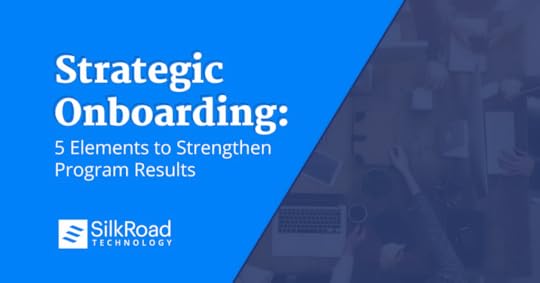
(Editor’s
Note: Today’s article is brought to you by
our friends at SilkRoad Technology
,
a provider of strategic onboarding solutions to drive workforce readiness and
organizational transformation. Check out their research, “
The Value
of Employee Engagement in the Age of Digital Disruption
”
a valuable report for any HR leader who wants to see engagement and onboarding
from the C-suite. It’s a must-read for any human resources professional. Enjoy
the article!)
I’ve
mentioned a few times a statistic from Korn Ferry saying 98 percent
of executives feel that onboarding programs are a key factor in employee
retention efforts. With unemployment at
historic lows, organizations can’t afford turnover. It’s much too costly and it
has an impact on employee morale and the customer experience.
However,
in the SilkRoad
Technology Report: U.S. Trends and Applications in Employee Onboarding, most
companies do not plan to focus meaningfully on their onboarding programs
despite views that they could do more with their existing programs. I had the chance to speak with Robert Dvorak, president and CEO
of SilkRoad Technology, about the impact this could have on business. “These
results paint a picture of a corporate environment that is not utilizing the
full potential of its greatest assets – its people – through onboarding,
learning and performance programs for employee development and training.
Companies must adopt strategies to monitor change, prepare their entire
workforce – not just new hires – with the skills they need, and continually
‘onboard’ them to new roles of business value and relevance.”
5 Key Elements of Strategic Onboarding
So how can organizations add some substance to
their existing onboarding programs? The answer involves adding some strategic
elements. Here are five I learned about during SilkRoad’s annual Connections
Conference.
ELEMENT #1 – Customize the employee onboarding experience. Strategic onboarding is about defining the new hire experience to have more than the basics. In many companies, new hire onboarding is about administrative tasks such as filling out paperwork and learning how to operate equipment, etc.
Strategic
onboarding is about customizing the onboarding experience for the employee. In the book, “Successful
Onboarding: A Strategy to Unlock Hidden Value Within Your Organization”, co-author Lilith Christiansen talks about providing new hires
with four state-of-the-art strategic topics.
Cultural mastery helps new hires understand the company culture, traditions, and rituals. Interpersonal network development teaches employees how to build positive working relationships, including how to gain perspective from others. Early career support includes giving new hires the tools to evaluate their own skills and learning along with how to manage their own career development.Strategy immersion and direction gives new hires a stronger sense of purpose by sharing with them what the organization does, why it does it, and where it’s headed.
ELEMENT #2 – Adopt core preboarding. And a year of “firsts”. I’ve always said that while orientation programs can take hours or days, onboarding really takes a year. There are so many things that a new employee needs to experience to truly feel a part of the organization. A few examples include: completing your first expense report, going on your first sales call, doing your first presentation, completing your first goal or project, making it though “busy season” and maybe even “low season, celebrating your first professional success, and of course, meeting for your first performance review.
It’s time
to add a strategic component to our preboarding efforts. Yes, it’s great to
take care of some administrative tasks during preboarding, but don’t forget to
talk about the ‘firsts’ and how the company will be there for support.
ELEMENT #3 – Design a “beyond onboarding” experience. Many of you might be saying, “I get it. Onboarding needs to be more comprehensive. It needs to be longer to support employees at a higher level.” And that’s true. But organizations can’t simply tell an employee on their first-year anniversary with the company, “Okey dokey, you’re done now.” Companies need to design a transition from onboarding to the employee experience. It should include the entire employee journey from recruiting to projects. Department transfers to acquisitions. Family leave to offboarding. And alumni to boomerang.
In the
SilkRoad report, more than two-thirds of respondents (68%) say that onboarding
is treated as a static event in their company, not a continuous process. Only
11% of HR decision-makers with new hire onboarding say their onboarding never
ends and is continuous.
Global
research and advisory firm Gartner considers onboarding to be the bridge
between recruitment and the employee experience with it lasting at least
through the end of the new hire’s first year. Analyst Jason Cerrato highlights in their
report Overhauling
Onboarding: Using Updated Capabilities and Design Thinking to Move Beyond
Compliance to Care how to apply design thinking approach
to reinvent the new hire experience by putting the employee at the center,
applying empathy and moving beyond compliance to deliver an experience that improves
the new hire engagement and time to productivity.
ELEMENT #4 – Measure and evaluate the program. Dvorak’s comment earlier in the article suggests that companies face significant challenges in adapting their onboarding programs to the coming business changes. Being able to measure the performance of onboarding and then use the results to take action is essential. In the report, one-third of HR decision-makers (33%) say measuring how well their onboarding program performs against key performance indicators (KPIs) is one of the top three biggest onboarding challenges they are facing, followed by personalization of the new hire experience (31%), improving new hire engagement (30%), and implementing changes quickly (29%).
HR
departments can use Dr. Donald
Kirkpatrick’s Levels of Training Evaluation
to guide their measurement process. Level 1 evaluations could focus on administrative
efficiencies. Level 2 evaluations would include metrics like time to
productivity. Level 3 evaluations are focused on employee engagement and Level
4 evaluations are linked to employee retention. If you want to take it one step
further, consider a Level 5 return-on-investment (ROI) evaluation (FYI – The
Level 5 evaluation was introduced by Dr. Jack Phillips.)

ELEMENT #5 – Create onboarding content areas. Typically, these types of lists end with measurement and evaluation, but I thought this element was something organizations could do with the results they calculate. In the elements we’ve discussed so far, we’ve talked about content. I was surprised to read in the report that less than two in three respondents (65%) say their company’s onboarding program does a great job of upskilling or reskilling existing employees for the next step in their career.
Relevant
content is essential for any onboarding program. In the case of strategic
onboarding, think of content as not only helping employees be successful in
their current role but also getting employees ready for the next opportunity. Onboarding
content could drive career development programs and be the foundation for succession
planning or talent pools.
Strategic
Onboarding Prepares Organizations for Business Change
Organizations
have the ability to use their onboarding programs for much more than simply
getting new hires on the payroll and training them. Strategic onboarding
programs allow organizations to align talent management with long-term business
objectives. But it takes having a well-thought out strategy and executing it
flawlessly.
If you
want to learn more about where your organization is on the onboarding scale and
how to get to the strategic level, check out this SilkRoad on-demand webinar “Onboarding
Maturity: The Big Impact of a More Mature Onboarding Program”
featuring Lilith Christiansen, vice president of onboarding solutions.
The post Strategic Onboarding: 5 Elements to Strengthen Program Results appeared first on hr bartender.






January 19, 2020
Workplace Investigations: Trash Talk and Hearsay – Ask #HR Bartender

As an HR pro, there are two things that I’ve had to investigate repeatedly. The first is employees using inappropriate language. Call it trash talk, smack talk, or whatever. The second is complaints that one employee is being disciplined for something that other employees do (and don’t get disciplined). Today’s reader note has both.
I am a supervisor for a municipality. Can my employer terminate me on hearsay accusations when the persons accusing me aren’t being held accountable for the same thing? I was told that I’m being suspended for inappropriate talk when the accusers say far worse than myself and are not being held to the same standard. I am fearing termination, but the accusers have admitted doing the same. What are my rights? Everyone is subject to the same rules, right?
I realize there are so many things we don’t know about this situation. But we can talk about using inappropriate language in the workplace and what happens when someone is being held accountable (and feels others are not).
To help us unpack this situation, I asked our friend Heather Bussing if she would lend us her valued experience and thankfully she said “yes”. Heather is an employment attorney and regular contributor at HR Examiner. She’s helped us on several occasions and this post about the importance of job references is still one of my favorites.
Please don’t forget that Heather’s comments shouldn’t be construed as legal advice or as pertaining to any specific factual situations. If you have detailed questions, they should be addressed with your friendly neighborhood labor and employment attorney.
Heather, before we start talking about suspensions, I want to talk about inappropriate language in the workplace. Why do organizations hold employees – especially supervisors – accountable for “trash talk” or inappropriate language?
[Bussing] Employers are liable for the things their employees do in the course of their employment. With harassment law, employers are liable for the things their managers do because that’s who deals with employees on behalf of the organization. Trash talk and inappropriate language can rise to the level of a hostile work environment and constitute harassment based on any protected class such as gender, race, or religion.
While being mean or a jerk under circumstances not related to a protected class is usually legal, employers don’t really want their managers or any employees to be jerks because it makes employees quit. And replacing employees is expensive. If the workplace gets really difficult, it can get hard to hire people. Then the work doesn’t get done and the business fails. So, having a place to work where people are not jerks is important to the bottom line and sometimes the existence of the business itself.
This reader says that they have been suspended for inappropriate talk. And the employees who accused them of it have done the same thing (without repercussions). Should employees focus on what happens to other employees? Or should they be more focused on their own performance?

[Bussing] Treating one employee differently from another and enforcing rules against one set of workers but not another when the rules should apply to everyone is a classic basis for showing discrimination.
On the other hand, if what one person did is really bad and what the other person did is not so bad, then the organization has some discretion about how to enforce the rules.
So, arguing that the rules aren’t being fairly enforced can be an effective argument. But only if your own actions can be justified or are truly not that bad. You need a reasonable position based on your own actions before comparing your situation to how others were treated.
Let’s move on to the mention of hearsay. What is hearsay?
[Bussing] Hearsay is a technical legal term about the reliability and admissibility of evidence in a court proceeding. In an internal employment disciplinary investigation, there is no hearsay in the legal sense. There is a lot of he said, she said, they said, interviews, speculation, assertions, opinions, and assorted emails, text messages, IM’s and documents that offer context for all the things that various people say, feel, and think. All of this is valid and important information and is useful in an investigation of workplace harassment or conflict.
When the reader asks whether they can be terminated based on ‘hearsay accusations’, the answer is sure. It happens all the time. I would hope there would be additional inquiry even if there is no formal investigation, especially for a termination. But often, the only way that an employer learns about what’s going on is from the grapevine where people talk about things they heard about.
You mentioned investigations and inquiries. If an employee feels that a policy isn’t being administered consistently, should they tell HR? Doesn’t this just look like “sour grapes” and won’t be taken seriously?
[Bussing] It depends on the situation and what happened. It also depends on why the policy is not being administered consistently. If it’s some form of discrimination, then yes, it’s generally a good idea to raise it. But first it’s essential for the employee to assess whether there will be retaliation, the chance that things might actually change, and whether they want to spend their time and energy dealing with it.
The best thing I can say without knowing more is to get some help before raising any employment concern. If you’re in a union, start with your union representative. If not, then find a friendly manager or someone you can trust who has experience dealing with workplace conflict and get some advice. Calling an employment lawyer can also be a good idea if you think that discrimination or retaliation are involved and that there is little chance of informal resolution within the organization’s normal channels.
HR should be and often is caring and concerned about whatever employees bring them. But if its a personality conflict and everyone is behaving badly, then escalating the situation can just create more drama and distraction. These situations often end with both people leaving, either voluntarily or involuntarily.
One other thing to consider: It may be better to give up trying to win the situation and figure out whether you would be better off working somewhere else. Even if it seems unfair that the jerk gets away with it, you are better off working someplace where you are appreciated and don’t have to deal with jerks.
The reader ended their note asking about their rights. We don’t know where they are located, etc. That being said, where can employees find information about the company’s discipline process?
[Bussing] This particular reader appears to be a municipal/government employee. Depending on the state, government employees can be dealing with statutory rules, administrative regulations, union contracts, and agency or departmental policies. Usually, it’s a combination. If you have a union, start there. If there’s no union, then ask HR about the written policies on discipline. Even with governmental entities, a lot of that information is available digitally through an employee portal or resource site.
For non-union and non-governmental employees, the employee handbook is usually the best place to start. HR will have copies. You were probably given a copy when you started or it is available digitally in the employee portal or policy section of the employer’s internal communications site.
Last question. We’ve been talking about the employee. I’d like to close by asking you about the company. If the organization isn’t administering discipline consistently, does this put the company at risk? Why or why not?
[Bussing] One of the reasons I hate lots of policies is that there is no way that any rule or policy can account for every situation. There will inevitably be exceptions, often for very good reasons. But once an organization starts enforcing rules against some people, while the same rules don’t seem to apply to others, there is risk that someone will complain that it is discriminatory. And frankly, it often is.
I hope you’ll join me in extending a HUGE thanks to Heather for sharing her experience and knowledge with us. There are many times when the right answer to a situation isn’t clearly spelled out and we need to investigate all of the variables.
I want to extend another huge thank you to all of you who take the time to send me your notes and questions. It does take a while to research and publish the answers, but I hope you find them worthwhile. Because I know if one person is thinking about this, there are probably others who would like to know the same thing.
Image captured by Sharlyn Lauby somewhere off the coast of Mexico
The post Workplace Investigations: Trash Talk and Hearsay – Ask #HR Bartender appeared first on hr bartender.






January 17, 2020
Flextime: Organizations Should Make it More Flexible
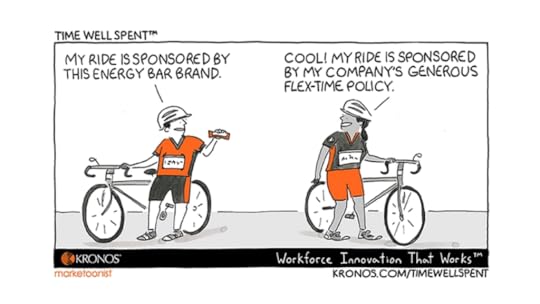
Today’s Time Well Spent
from our friends at
Kronos reminded me that we need to be more flexible
when it comes to employee’s work time. I’d like to think organizations know
that.
But it also reminded me that it’s possible
we’ve put up barriers to keep this from happening. For example, is it possible
that we’ve made programs designed to help employees – like flextime –
inflexible? You know what I mean. Organizations might have created a flex-time
policy or program but placed so many rules and restrictions on it that flextime
isn’t actually very flexible.
Maybe we need to look at how we view flextime.
Think of flexibility in three ways: places, days, and hours. There are so many terms out there associated with some sort of flexible work – remote work, virtual work, flexible time, telework, etc. You get my point. I like to think of flextime in three ways: 1) the place where you work, 2) the days of the work week, and 3) the work hours in a day. Not every employee can have flexibility in all three areas. But it’s possible that most jobs can have flexibility in at least one of them.
Managers need to be trained on how to approve flextime. Dare I say, it’s easy to create an inflexible schedule. It’s much more challenging to put the puzzle together known as employee flextime. Organizations should give managers the training and support they need to work on the puzzle, so to speak. We want managers to engage and retain workers. This is one way to do it – by giving employees a flexible work schedule. It also doesn’t hurt that employees will see managers putting in the effort to make it happen.
Let employees know in advance when flexibility will be a challenge. The first two points in this post have been focused on giving employees something they really want – flexibility. I know some of you might be saying, “There’s no way we can do this all the time. Our business just doesn’t allow.” I get it. And your employees will too. If you tell them in advance. So, when there’s going to be a big deadline or business is super busy, let employees know. “I know some of you are accustomed to more flexibility, but I’m not going to be able to do that this week.”
I’ve always thought that if managers worked
really hard to give employees flexibility then when those times occur when they
can’t, employees would be understanding. Just tell people in advance, so they
can make arrangements.
Flextime is something that employees would
love to have. It’s
a huge selling point in the employee value proposition (EVP).
And honestly, it can cost very little to do. What’s even better is that today’s
technology can help make it happen.
The post Flextime: Organizations Should Make it More Flexible appeared first on hr bartender.






Sharlyn J. Lauby's Blog
- Sharlyn J. Lauby's profile
- 10 followers



